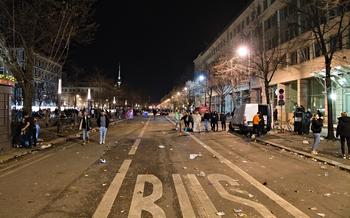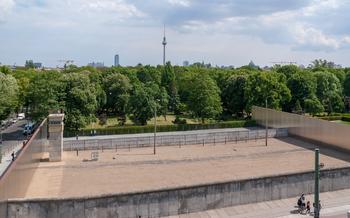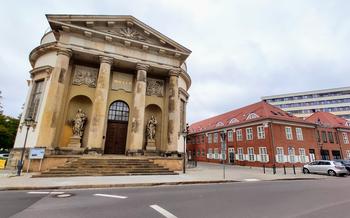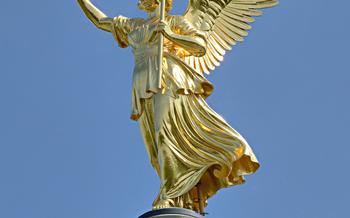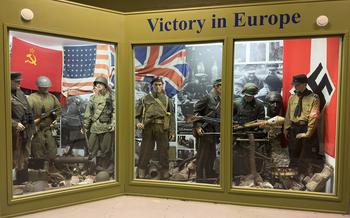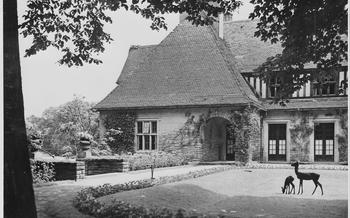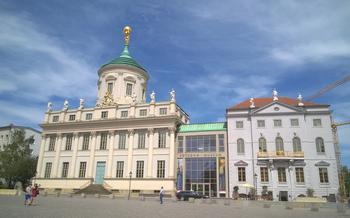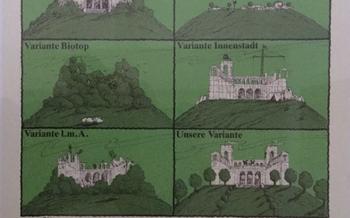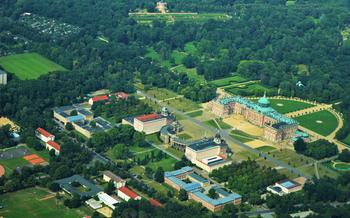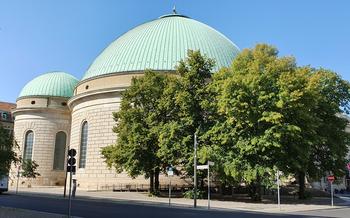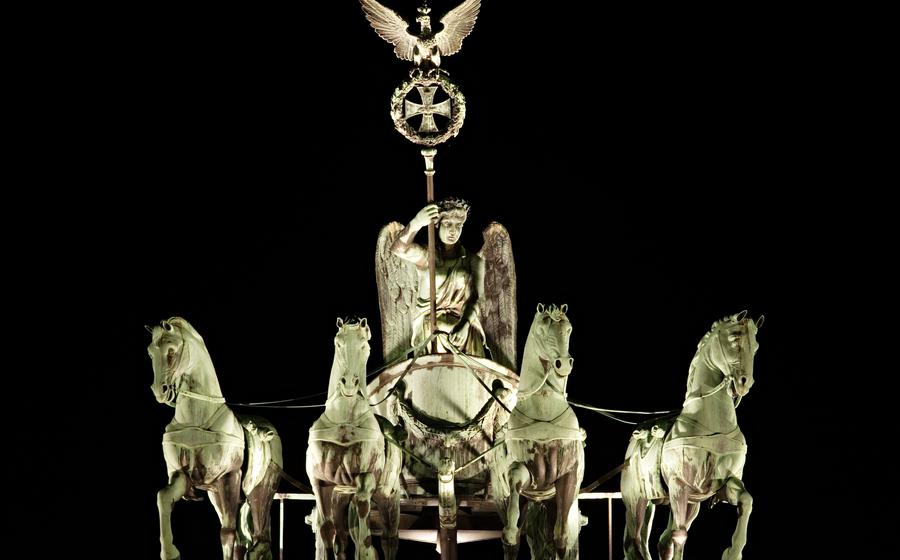
Brandenburg Gate
- Brandenburg Gate: A Symbol of Unity and Division
- Location and Accessibility
- Historical Background
- Architectural Highlights
- Surrounding Area
- Historical Events
- Cultural Significance
- Things to Do
- Photography Tips
- Tips for Visiting
- Nearby Attractions
- Historical Figures
- Fun Facts
- Frequently Asked Questions
- Insider Tip
Brandenburg Gate: A Symbol of Unity and Division
The Brandenburg Gate stands as a testament to Berlin's rich history and its journey from division to reunification. Initially commissioned by King Frederick William II in 1788, the gate was designed by Carl Gotthard Langhans, who took inspiration from the Propylaea, the monumental entrance to the Acropolis in Athens. Completed in 1791, the gate was originally called the Brandenburg Gate, signifying its location at the end of Unter den Linden, the grand boulevard leading from the royal palace to the Tiergarten park.
The gate's neoclassical design features 12 Doric columns, six on each side, supporting a massive entablature and a triangular pediment. Atop the pediment stands the Quadriga, a four-horse chariot driven by the goddess Victoria, added in 179The Quadriga has become an iconic symbol of the gate and Berlin itself.
Throughout its history, the Brandenburg Gate has witnessed pivotal events that have shaped Germany's destiny. Napoleon Bonaparte rode through the gate in triumph in 1806 after defeating the Prussian army at the Battle of Jena-Auerstedt. During the Nazi regime, the gate served as a backdrop for propaganda rallies and military parades. In 1945, the gate was damaged during the Battle of Berlin and later restored.
The Brandenburg Gate became a powerful symbol of division during the Cold War, as it stood on the border between East and West Berlin. In 1961, the Berlin Wall was built, sealing off West Berlin from East Germany. The gate was closed, and no one was allowed to pass through.
The fall of the Berlin Wall in 1989 marked a turning point in the history of the Brandenburg Gate and symbolized the reunification of Germany. On December 22, 1989, the gate was opened, and people from both sides streamed through, celebrating the end of division. The Brandenburg Gate had become a symbol of hope, freedom, and unity.
Today, the Brandenburg Gate stands as a powerful reminder of Berlin's past and its journey towards unity. It is one of the most iconic landmarks in the city and a must-visit destination for anyone interested in history, culture, and architecture.
Location and Accessibility
The Brandenburg Gate stands in the heart of Berlin, at the end of the famous Unter den Linden boulevard. It is conveniently located near other major attractions such as the Reichstag Building, the Holocaust Memorial, and Museum Island. The gate is easily accessible by public transportation, with several metro and bus lines stopping nearby. The address of the Brandenburg Gate is Pariser Platz, 10117 Berlin, Germany. It is open to the public 24 hours a day, but the best time to visit is during the day or early evening when the light is at its best for taking photos.
Historical Background
The Brandenburg Gate, a majestic symbol of Berlin and Germany, stands proudly as a testament to the city's rich and complex past. Its construction began in 1788 under the reign of King Frederick William II, who commissioned the gate as a symbol of peace and unity. The design was inspired by the Propylaea, the monumental gateway to the Acropolis in Athens, Greece. Originally known as the Brandenburg Gate, it served as a triumphal arch to commemorate Prussia's military victories.
During the Napoleonic Wars, the gate witnessed a significant historical event. In 1806, Napoleon Bonaparte triumphantly rode through the gate after defeating the Prussian army at the Battle of Jena-Auerstedt. As a symbol of his victory, he removed the Quadriga statue, a four-horse chariot driven by the goddess Victoria, and took it to Paris. The statue was eventually returned to Berlin in 1814 after Napoleon's defeat.
The Brandenburg Gate became a poignant symbol of division during the Cold War. Standing on the border between East and West Berlin, the gate was a physical manifestation of the ideological and political divide that separated the city and the nation. The gate became a symbol of hope and freedom for those living in East Berlin, who yearned for reunification with the West.
Architectural Highlights
The Brandenburg Gate stands as a testament to neoclassical architectural prowess. Designed by Carl Gotthard Langhans, the gate exudes an aura of grandeur with its imposing sandstone structure. Its facade is adorned with 12 Doric columns, six on each side, creating a sense of symmetry and strength. The crowning glory of the gate is the Quadriga statue, a four-horse chariot driven by the goddess Victoria. Added in 1793, the Quadriga symbolizes triumph and victory. The intricate details and harmonious proportions of the Brandenburg Gate make it an architectural masterpiece that continues to captivate visitors from around the world.
Surrounding Area
The Brandenburg Gate stands in the heart of Berlin, surrounded by several notable landmarks and attractions. Directly in front of the gate lies Pariser Platz, a historic square that has witnessed significant events throughout history. The square is adorned with various sculptures and monuments, including the Brandenburg Gate Museum, which offers insights into the history and significance of the gate itself.
Just a short walk from the Brandenburg Gate, you'll find the Reichstag Building, the seat of the German parliament. This impressive glass-domed building is a striking example of modern architecture and offers guided tours for visitors.
Adjacent to the Brandenburg Gate, you can explore the Tiergarten Park, a vast green oasis in the heart of Berlin. This expansive park offers a tranquil escape from the city's hustle and bustle, with its lush gardens, serene lakes, and numerous attractions, including the Berlin Zoo and the Victory Column.
Historical Events
The Brandenburg Gate has witnessed many significant historical events throughout its existence. In 1806, Napoleon Bonaparte famously rode through the gate in triumph after defeating Prussia at the Battle of Jena-Auerstedt. During World War II, the gate sustained significant damage from Allied bombing raids. After the war, the gate became a symbol of the division between East and West Berlin, as it stood on the border between the two sectors.
In 1989, the Brandenburg Gate became a symbol of German reunification when it was opened to the public after the fall of the Berlin Wall. Thousands of people gathered at the gate to celebrate the reunification of their country. Since then, the gate has been a popular tourist destination and a venue for various events and celebrations.
Cultural Significance
The Brandenburg Gate holds immense cultural significance as a symbol of Berlin and Germany. Its iconic status is reflected in its frequent portrayal in art, literature, and media. The gate's image has been featured on postage stamps, coins, and even the logo of the German national football team. It has also served as a backdrop for numerous movies, TV shows, and music videos, further solidifying its place in popular culture.
The gate's cultural significance extends beyond its physical presence. It has become a symbol of unity, resilience, and freedom. After the fall of the Berlin Wall, the Brandenburg Gate became a symbol of German reunification, representing the end of decades of division and the beginning of a new era of unity and cooperation. Today, the gate stands as a reminder of Germany's rich history and its enduring spirit.
Whether you're a history buff, an architecture enthusiast, or simply someone who appreciates iconic landmarks, a visit to the Brandenburg Gate is a must-do experience. This majestic monument encapsulates the essence of Berlin and Germany, offering a glimpse into their past, present, and future.
Things to Do
Beyond simply admiring the gate's architectural grandeur, there are several things you can do to enhance your visit to the Brandenburg Gate:
-
Visit the Brandenburg Gate Museum: Located at the base of the gate, this museum provides a comprehensive overview of the gate's history, from its construction to its role in major historical events. Through interactive exhibits and multimedia presentations, you'll gain a deeper understanding of this iconic landmark.
-
Take a Walk Through Pariser Platz: The square in front of the gate, Pariser Platz, is a historic site in its own right. Admire the surrounding architecture, including the Brandenburg Gate Museum, the Hotel Adlon, and the French and American embassies. Pariser Platz is also home to several restaurants and cafes, offering a chance to relax and soak in the atmosphere.
-
Explore Tiergarten Park: Adjacent to the Brandenburg Gate, Tiergarten Park is a vast green oasis in the heart of Berlin. Take a leisurely stroll through the park, admire the lush gardens, and visit the nearby attractions, such as the Berlin Zoo, the Aquarium Berlin, and the Soviet War Memorial.
-
Attend Events: The Brandenburg Gate is often used as a venue for events and celebrations. From concerts and festivals to political rallies and historical reenactments, there's always something happening at the gate. Check the official website or local event listings to see what's on during your visit.
Photography Tips
Capturing the grandeur of the Brandenburg Gate through photographs is a must-do for any visitor to Berlin. Here are some tips to help you take stunning photos of this iconic landmark:
-
Best Time for Photos: The best time to take photos of the Brandenburg Gate is during the day, when the natural light is at its brightest. This will ensure that you get clear and vibrant shots. However, if you're looking for more dramatic lighting, consider visiting the gate at dusk, when the sky is ablaze with color.
-
Composition: When composing your shot, consider using wide-angle lenses to capture the entire gate and the surrounding area. This will help you create a sense of scale and grandeur. Experiment with different angles to find unique perspectives. For example, try shooting from a low angle to emphasize the height of the gate, or from a distance to capture the gate within the context of the cityscape.
-
Lighting: Natural light is your best friend when photographing the Brandenburg Gate. Avoid shooting during harsh midday sun, as this can create harsh shadows and overexposed areas. Instead, opt for softer lighting conditions, such as early morning or late afternoon. If you're shooting at night, use a tripod to stabilize your camera and avoid blurry shots.
-
Unique Angles: Don't be afraid to experiment with different angles to capture unique perspectives of the Brandenburg Gate. Try shooting from the side to capture the gate's intricate details, or from behind to create a sense of depth. You can also climb the steps of the Reichstag Building for a bird's-eye view of the gate.
Tips for Visiting
To make the most of your visit to the Brandenburg Gate, here are a few tips:
-
Avoid Crowds: The Brandenburg Gate is a popular tourist destination, so it can get crowded, especially during peak season. To avoid the crowds, try to visit early in the morning or late in the evening.
-
Guided Tours: If you want to learn more about the history and significance of the Brandenburg Gate, consider joining a guided tour. Tours are available in various languages and can provide insights into the gate's past and its role in German history.
-
Accessibility: The Brandenburg Gate is wheelchair accessible, and ramps and elevators are available for those who need them.
-
Safety: Like any major tourist attraction, the Brandenburg Gate can attract pickpockets and other petty criminals. Be aware of your surroundings and keep your belongings safe.
Nearby Attractions
In the vicinity of the Brandenburg Gate, a plethora of captivating attractions awaits. The Reichstag Building, the seat of the German parliament, stands as a testament to the country's rich history and democratic values. Its awe-inspiring glass dome offers panoramic views of the city, providing a unique perspective on Berlin's architectural tapestry.
Just a short walk away, the Holocaust Memorial, a poignant tribute to the victims of the Holocaust, serves as a stark reminder of the atrocities committed during World War II. Its haunting rows of concrete slabs create a powerful and moving experience, honoring the memory of those who lost their lives.
For those with a passion for art and culture, Museum Island, a UNESCO World Heritage Site, beckons with its ensemble of five world-class museums. Here, visitors can immerse themselves in a treasure trove of artistic masterpieces, spanning from ancient artifacts to modern masterpieces.
Last but not least, Charlottenburg Palace, one of the largest and most opulent palaces in Berlin, offers a glimpse into the grandeur of the Prussian monarchy. Its sprawling gardens, adorned with elegant sculptures and fountains, invite visitors to stroll and admire the architectural splendor of this magnificent palace.
Historical Figures
King Frederick William II, the ruler of Prussia at the time, commissioned the construction of the Brandenburg Gate as a symbol of peace and prosperity. Carl Gotthard Langhans, a renowned architect known for his neoclassical designs, was chosen to bring the king's vision to life. The gate's Quadriga statue, a four-horse chariot driven by the goddess Victoria, was added in 1793 and became a symbol of Prussian power.
In 1806, Napoleon Bonaparte famously rode through the Brandenburg Gate in triumph after defeating Prussia at the Battle of Jena-Auerstedt. This event marked the beginning of the Napoleonic Wars, which would eventually lead to the gate's destruction and subsequent reconstruction.
After World War II, the Brandenburg Gate became a symbol of the division between East and West Berlin. It stood on the border between the two sectors of the city, with barbed wire and armed guards preventing people from crossing. Willy Brandt, the first Chancellor of West Germany, made a historic visit to East Berlin in 1963 and stood in front of the Brandenburg Gate, symbolizing his hope for reunification.
In 1989, the Berlin Wall fell, and the Brandenburg Gate became a symbol of German reunification. People from both sides of the city gathered at the gate to celebrate their newfound freedom and unity. Today, the Brandenburg Gate stands as a testament to the resilience of the German people and the power of unity and peace.
Fun Facts
The Brandenburg Gate is steeped in history and is associated with several intriguing fun facts:
-
Quadriga Controversy: In 1806, Napoleon Bonaparte triumphantly rode through the Brandenburg Gate and famously took the Quadriga statue with him to Paris as a war trophy. The Quadriga was eventually returned to Berlin after Napoleon's defeat in 1814 and restored to its rightful place atop the gate.
-
Bullet Holes: The Brandenburg Gate still bears visible bullet holes from World War II, serving as a poignant reminder of the destruction and devastation the city endured during the conflict.
-
Reunification Celebration: The Brandenburg Gate played a pivotal role in the historic reunification of Germany in 198On November 9, 1989, the Berlin Wall fell, and the gate became a symbol of unity and freedom as people from both East and West Berlin streamed through the iconic landmark in celebration.
-
UNESCO World Heritage Site: The Brandenburg Gate is part of the UNESCO World Heritage Site "Museumsinsel (Museum Island), Berlin." This designation recognizes the gate's outstanding universal value and its significance as a cultural and historical landmark.
Frequently Asked Questions
Is the Brandenburg Gate free to visit? Yes, admission to the gate and the surrounding area is free of charge. Visitors can explore the gate and take photos without any entrance fees.
Can I climb to the top of the Brandenburg Gate? No, it is not possible to climb to the top of the gate for security reasons. The Quadriga statue on top of the gate is inaccessible to the public, and there are no stairs or elevators leading to the top.
Are there any restrictions on visiting the Brandenburg Gate? The gate is open to the public 24/7, but certain areas may be restricted due to events or security concerns. During special events or national holidays, there may be temporary restrictions on access to the gate. It is always advisable to check for any closures or restrictions before planning a visit.
Insider Tip
For a truly magical experience, visit the Brandenburg Gate at night. The gate is beautifully illuminated, casting a warm glow over the surrounding area. The lights create a stunning backdrop for photos, and the gate takes on a whole new character in the darkness. Whether you're a photographer, a history buff, or simply someone who loves to soak up the atmosphere of a city, a night visit to the Brandenburg Gate is an experience you won't forget.
